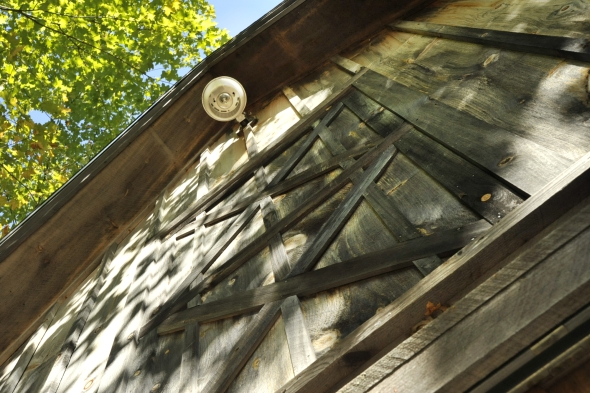 The other night, I got to wondering how long the shop area light had been in service. A thought which, apparently, triggered some level of subconscious psychokinesis and caused the bulb to burn out. “Blink” and the world was in total darkness. Total darkness, in this circumstance, means living and working in the midst of dense woodland, far from an unlit frontage road and on a moonless night. The condition does not particularly bother me, but it does bother my wife as the state of pitch black outside somehow disturbs her sleep.
The other night, I got to wondering how long the shop area light had been in service. A thought which, apparently, triggered some level of subconscious psychokinesis and caused the bulb to burn out. “Blink” and the world was in total darkness. Total darkness, in this circumstance, means living and working in the midst of dense woodland, far from an unlit frontage road and on a moonless night. The condition does not particularly bother me, but it does bother my wife as the state of pitch black outside somehow disturbs her sleep.
Area lights are rascals. The bulb life is measured in multiples of years and are frequently obsolete by the time a replacement is needed. Five years ago, the shop light was changed from mercury vapor to CFL technology, for a reason made obvious at the beginning of this sentence. Unfortunately, a stubby, mogul socket, 6U CFL bulb is no longer in production, only the anemic 2U, the overly long 4U and more abstract HeyU and CU remain. Subsequently, a twelve year old mercury vapor lamp was dug out of a “for future needs” pile, at the back of the shop loft and the changing of the bulb ceremony commenced.
The area light fixture is at the peak of the shop’s roof gable, twenty five feet off the ground. It is a full arm’s stretch from the top of an extension ladder with the ladder’s feet resting on a sharply inclined entry ramp. With ladder in position; the first ladder ascent. A wasp nest was sighted on the top of the large light fixture, wasps began flying reconnaissance sorties; first ladder descent. A large can of wasp spray was fetched from the garden shed, a long sleeve sweatshirt was donned; second ladder ascent. With no wasp activity sightings, my wife shouting encouragement from her ladder anchoring position, a grab for the burned out bulb was initiated. An angry wasp flew in hot with the sun to its back. I ducked, he made a tight turn. I drew the wasp spray and caught him in my sights. Nothing. Full can, no propellant, expiration date 2001; rapid second ladder descent.
Wife’s encouragement turned to chiding. Terms being bandied about, “Suck it up”, “Stop whining, it’s embarrassing”, “It’s a good thing your children aren’t here to see this”. Tough love. Third ladder ascent. Caught between a wasp nest, a long potential fall and a pressuring spouse holding the ladder, the old bulb was removed; third ladder descent. With Mercury vapor lamp shielded in protective wrap, wife’s taunts subsiding and with the wire handle of fly swatter tucked in a back pocket; fourth ladder ascent. Legs extended, body extended, free arm and hand extended. The new bulb would not start into its socket. The new bulb would not start into its socket. The new bulb would not start into its socket. The new bulb would not start into its socket. The new bulb would not start into its socket. No doubt sensing my desperation, the wasps launched an all out attack and I had a “King Kong atop of the Empire State Building” moment.
Legs clamped to rungs, a perfect state of symmetry and balance, one hand twisting the bulb into place, the other waging war against the wasps with a fly swatter. Finally, the fourth and final ladder descent. Now all I have to do is wait until dark to see if the light comes on, or if the bulb found in the loft was the one I changed out five years ago.
********

For folks who live in rural areas, firearms are as much a part of the routine of life as ladders, wasps and changing area lights. Not close to public safety services, there is a need to provide for ones own safety and security. Working or trail walking in surrounding wooded areas, there is a need for protection from assertive large animals that may take exception to the notion of sharing habitat and protection from species like fox, racoon and skunk and that sometimes contract rabies and like to share that gift with humans. Finally, firearm hunters may carry a rifle and/or handgun as a primary or secondary weapon. The norm is often out the door, gun on hip and on with the routine of the day.
|
Model 69 Combat Magnum |
|
| Company | Smith & Wesson |
| Point of Manufacturer | Springfield, MA |
| SKU # | 10064 |
| Type of Action | DA/SA |
| Caliber | 44 Magnum |
| Capacity | 5 |
| Barrel Length | 2.75″ |
| Barrel Material | Stainless |
| Rifling Twist Rate | 1:18.75″ RH |
| Frame Material | Stainless |
| Cylinder Material | Stainless |
| Finish | Bead Blasted |
| Grips | Soft Synthetic |
| Front Sight | Ramped, Orange Insert |
| Rear Sight | Adjustable W/E |
| Weight of Firearm | 34.4 Oz. |
| Overall Length | 7.8″ |
| Overall Height | 6.2″ |
| Width | 1.5″ |
| Key Lock | Yes |
| CA Certified | Yes |
| MA Certified | Yes |
| MSRP | $849 |
I got to looking at the Model 69 Combat Magnum as an offshoot of a 44 Magnum rifle project. I realize 44 Magnum revolvers have been very success within the context of medium and big game hunting, but I felt the benefits of a longer barrel rifle were significantly enhanced exterior and terminal ballistics. In side by side comparison of 4.6″ and 18.5″ barrel firearms, the 44 Magnum produced between 30% and 42% greater velocity with the longer barrel, dependent upon bullet weight.
There are times, however, when carrying a rifle may not be feasible; blazing boundaries and trails, stream fishing, gathering firewood, etc., but having a handgun holstered on a belt makes sense. There is a big difference between responsively drawing a revolver and trying to get to a rifle parked twenty feet away, on the other side of a bear who sees you as a fortuitous snack.
The Model 69, the first 44 Magnum built on the S&W medium size L frame, was introduced in 2014. The 4.2″ barrel Model 69 was addressed in detail within Smith & Wesson’s Model 69 Part I and Smith & Wesson’s Model 69 Part II. Earlier this year, the 2.75″ barrel Model 69 Combat Magnum version was introduced.
The original “Combat Magnum” was a lightweight 357 Magnum, introduced in 1955, built on a K Target frame; larger than a standard K Frame, but much lighter than the large N frame. In 1957, the Combat Magnum became the Model 19, which ran in production until 1999.
The L frame was introduced in 1983 as the basis for models that could handle a steady diet of 357 magnum ammunition. Lighter and more compact than the N frame, larger than the K Target frame, the K frame cylinder window is 1.82″ x 1.48″ where the L frame window is 1.82″ x 1.60″. The L frame is the basis for Models 581, 586, 681, 686, and 696, as well as for a number of Scandium/Titanium alloyed models. The L frame, with some modifications, is the basis for the Model 69 44 Magnum.
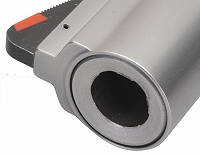 There were three basic changes made to the L Frame to accommodate the 44 Magnum. The most significant is the 5 shot cylinder which thickens outer and adjacent walls and locates the cylinder notches between chambers. A typical N frame 6 shot 44 Mag cylinder’s diameter is 1.710″, the Model 69 5 round cylinder is 1.560″. The N frame outer cylinder wall is approximately 0.035″ thicker than the 5 shot L frame, but the L frame space between cylinders is approximately 0.040′ greater.
There were three basic changes made to the L Frame to accommodate the 44 Magnum. The most significant is the 5 shot cylinder which thickens outer and adjacent walls and locates the cylinder notches between chambers. A typical N frame 6 shot 44 Mag cylinder’s diameter is 1.710″, the Model 69 5 round cylinder is 1.560″. The N frame outer cylinder wall is approximately 0.035″ thicker than the 5 shot L frame, but the L frame space between cylinders is approximately 0.040′ greater.
The barrel is a two piece assembly, a barrel and a shroud with the shroud locked to the frame (Below 1). The ejector rod is solid and no longer recessed to accept a spring loaded detent ball (2). Unlike the 4.25″ Model 69, the 2.75″ barrel Model 69 Combat Master’s detent ball is embedded in a lug affixed to the revolver’s frame and locks into the backside of the crane (3). The 4.25″ version of the Model 69 has a spring loaded detent ball embedded in the face of the crane, which locks into a notch in the rear of the barrel underlug
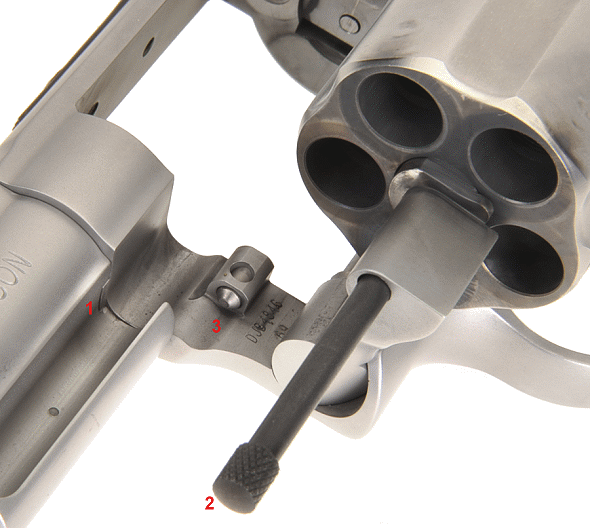
The square notch rear sight is windage and elevation adjustable. The front sight is raised and ramped with a bright , contrasting orange insert. Together they form a clean, sharp sight picture. The rear sight notch of the 4.25″ Model 69 is outlined in white.
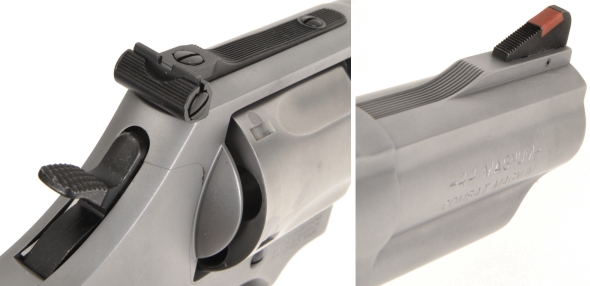
Sharing 44 mag and 44 revolver ammunition…

Rather than check out the Combat Magnum with factory ammo, I decided I would check it out with handloads assembled for a 44 Magnum bolt action hunting rifle. The feeling was that one would compliment the other in the applications previously noted and it was important that they shared a common handloaded ammunition supply.

Four component bullets were selected, all within a weight range of 240 grains to 300 grains, three are lead core jacketed and one hard cast lead alloy. The 270 grain Speer and 275 grain Cast Performance are intended for game heavier than deer, as determined by bullet construction and bullet manufacturer’s recommendations.The heaviest bullet, the 300 grain Hornady, is intended for deer and other game with a body weight of 300 pounds and under. As there was no intention of using the short barrel S&W Model 69 as a primary hunting firearm, why the heavy lead? The Model 69 would produce only moderate velocity, even with relatively light 44 Mag bullets. Subsequently, heavier bullets at moderate velocity would still produce a large wound channel and penetrate deeply.
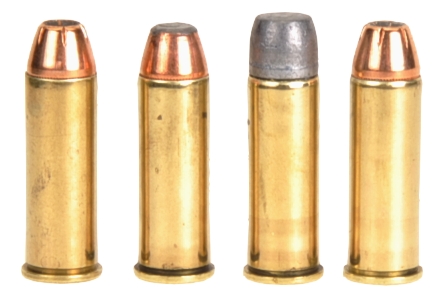
| COL and Capacity | Load Data & Performance | ||||||||
| Bullet | Bullet Type |
Bullet Weight Grains |
C.O.L. Inches |
Net Grains Water |
Powder | Charge Grains |
Muzzle Velocity FPS 18.5″ |
Muzzle Velocity FPS 2.75″ |
|
| Hornady HP/XTP | JHP | 240 | 1.600 | 25.5 | H110 | 25.0 | 1850 | 1212 | |
| Hornady HP/XTP | JHP | 240 | 1.600 | 25.5 | W296 | 25.0 | 1866 | 1191 | |
| Speer Deep Curl | JSP | 270 | 1.585 | 22.7 | H110 | 22.5 | 1657 | 1123 | |
| Speer Deep Curl | JSP | 270 | 1.585 | 22.7 | W296 | 23.0 | 1685 | 1148 | |
| Cast Performance | WFNPB | 275 | 1.655 | 26.3 | H110 | 24.0 | 1801 | 1134 | |
| Cast Performance | WFNPB | 275 | 1.655 | 26.3 | W296 | 23.5 | 1769 | 1095 | |
| Hornady HP/XTP | JHP | 300 | 1.600 | 19.9 | H110 | 20.0 | 1524 | 1068 | |
| Hornady HP/XTP | JHP | 300 | 1.600 | 19.9 | W296 | 20.0 | 1544 | 993 | |
Shooting personality…
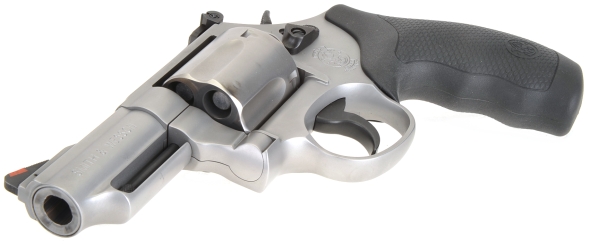
The combination of short barrel, velocity reduced in comparison to rifle barrel velocity and recoil absorbing grips did a lot to tame the S&W Model 69 Combat Magnum’s recoil. I would describe it as sharp, quick and with very little muzzle climb. For me it seemed a powerful, manageable and compact firearm to be carried comfortably on a belt holster and provide a good deal of protection anywhere in North America. Assembly and material quality is very good, aesthetics are clean and nothing shot loose in the face of relatively stout handloads. A good one from Smith and Wesson
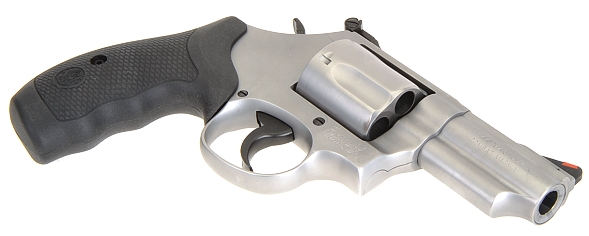

Email Notification